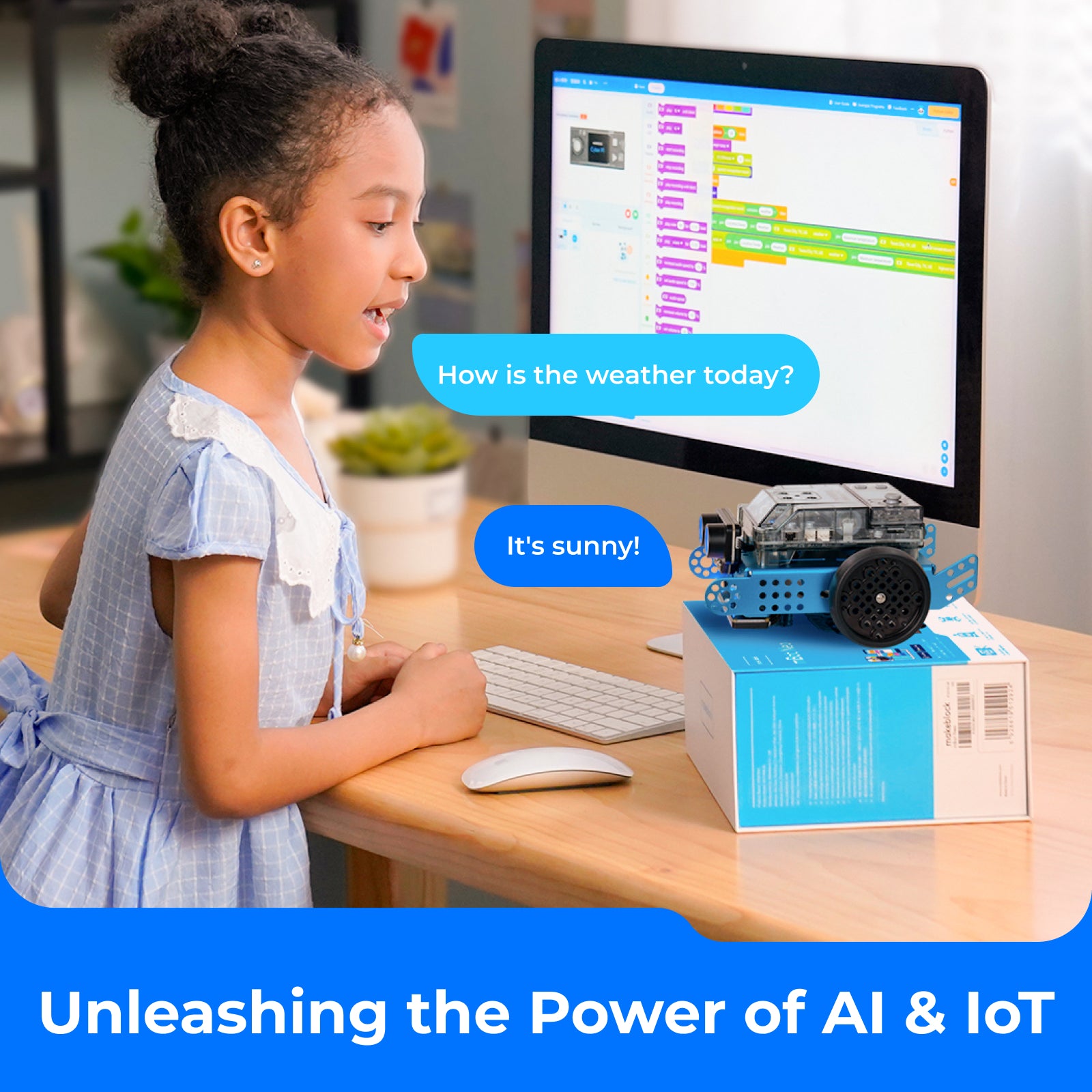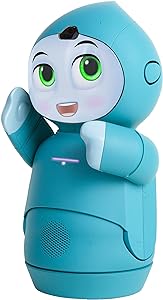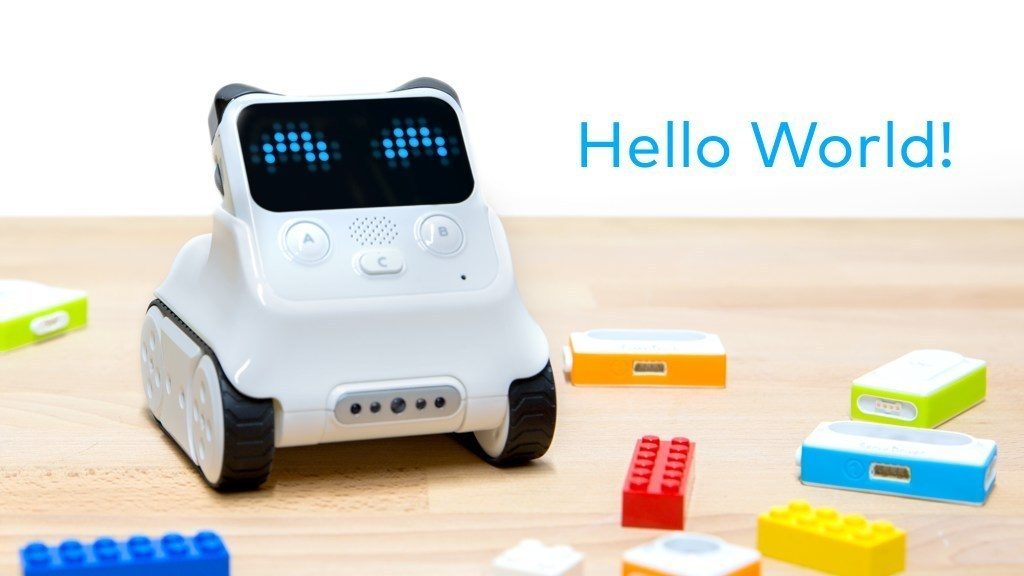Mar 15, 2024 | Makeblock
Artificial intelligence is a branch of computer science that seeks to develop technology to simulate the workings of the human brain. Combined with the field of robotics, AI has been used to develop and innovate intelligent machines that can be used for everything from manufacturing to facilitating education development.
An increasing number of AI robots are being integrated into various sectors, including logistics, manufacturing, healthcare, and education, bringing about significant benefits. Demand for AI-integrated robotics is driving significant growth in the industry. According to Markets and Markets, the AI robotics market is projected to exceed $35 billion by 2026.
Relationship Between AI and Robotics

Although AI and robotics are often conflated, they are separate but interconnected disciplines. While both have the potential to revolutionize industries and daily life, they serve distinct functions and operate according to different principles.
AI refers to the simulation of human intelligence processes by machines, particularly computer systems. It involves creating algorithms that allow computers to perform tasks that typically require human intelligence, such as learning, problem-solving, perception, reasoning, and language understanding. AI encompasses a broad range of techniques including machine learning, deep learning, natural language processing, computer vision, and more.
Robotics is a branch of engineering and science that deals with the design, construction, operation, and use of robots. A robot is a machine or mechanical device that is capable of performing tasks autonomously or semi-autonomously, often in response to sensory input. Robotics involves integrating various technologies such as sensors, actuators, control systems, and software to enable robots to interact with their environment and perform tasks effectively.
While AI plays a significant role in robotics by enabling robots to perceive, learn, and make decisions, robotics encompasses a broader scope beyond just AI. Robotics involves the physical design and mechanics of robots, as well as their control and operation, whereas AI focuses more on the intelligence and decision-making capabilities of machines. Many robots incorporate AI techniques to enhance their functionality, but not all AI applications involve robotics.
AI in Robotics

Artificial Intelligence and Robotics are two integral fields that revolutionize the world. AI robotics is the synergistic integration of artificial intelligence (AI) and robotics, resulting in machines that can perform tasks that typically require human intelligence. This field combines the physical capabilities of robots—such as manipulation, movement, and interaction with the environment—with the cognitive functions of AI, including learning, reasoning, perception, and decision-making.
As AI continues to advance, the capabilities of AI robotics are expected to grow, leading to even more sophisticated and capable robots that can perform a wider range of tasks and contribute significantly to various aspects of society and industry.
AI robots are being used in a variety of industries and applications, including manufacturing, education, healthcare, logistics, customer service, and research. They are revolutionizing the way we live and work by automating routine tasks, assisting in complex surgeries, providing companionship to the elderly, and exploring dangerous environments where humans cannot go. As AI technology continues to advance, the capabilities of AI robots are expected to expand, leading to even more innovative applications and a greater impact on society.
These robots are equipped with sensors, actuators, and computing power to perceive their environment, make decisions, and act upon those decisions. AI robots typically rely on various AI techniques such as machine learning, computer vision, natural language processing, and robotics to accomplish their tasks efficiently and effectively.
AI Robot Capabilities
AI robots, powered by advancements in artificial intelligence, exhibit a range of capabilities that enable them to perform complex tasks with a level of autonomy and intelligence. Here are some of the key capabilities of AI robots:
1. Perception and Sensory Integration: AI robots are equipped with an array of sensors that allow them to perceive their environment. These sensors can include cameras, microphones, touch sensors, and more, enabling the robots to gather data and respond appropriately to their surroundings.
2. Machine Learning and Adaptation: AI algorithms enable robots to learn from experience and improve their performance over time. They can adapt to new tasks, recognize patterns, and make predictions based on the data they have processed.
3. Decision-Making and Problem-Solving: AI robots can analyze situations, weigh options, and make decisions based on pre-programmed rules or learned behaviors. They can solve problems by applying logical reasoning and can even optimize their actions for better outcomes.
4. Natural Language Processing (NLP): Some AI robots are capable of understanding and generating human language, allowing them to communicate with users, interpret commands, and provide feedback in a more natural and intuitive way.
5. Precision and Repetitive Task Execution: AI robots can perform repetitive tasks with high precision and consistency, making them ideal for manufacturing, assembly lines, and other environments where accuracy is crucial.
6. Autonomous Navigation: AI robots can navigate complex environments autonomously, using techniques like SLAM (Simultaneous Localization and Mapping) to map their surroundings and plan their movements.
7. Collaboration and Teamwork: Advanced AI robots can work alongside humans or other robots, coordinating their actions for collaborative tasks. This capability is essential for shared workspaces and cooperative missions.
8. Physical Dexterity: AI robots can be designed with mechanical limbs and grippers that mimic human movement, allowing them to manipulate objects, perform delicate tasks, and handle materials with precision.
9. Predictive Maintenance and Fault Diagnosis: AI robots can monitor their own systems and predict when maintenance is needed, reducing downtime and improving reliability.
10. Integration with IoT and Smart Systems: AI robots can connect with the Internet of Things (IoT) devices and smart systems, becoming part of larger, interconnected networks that automate and monitor various processes.
These capabilities are continually evolving as AI technology progresses, leading to more sophisticated and capable AI robots that can operate in an increasingly diverse range of applications and environments.
Top AI Robots Picks
With the popularity of AI robots, many educators seek to incorporate them in their teaching. After several years of development, there are now advanced AI robots that are suitable for use in education. Here are some of the best AI robots and chatbots currently available, each with its unique capabilities and strengths.
1. mBot2

mBot2 by Makeblock is a coding robot designed to introduce students to AI concepts in a hands-on and engaging manner.
mBot2 is equipped with a series of sensors that allows it to recognize colors, shapes, and objects. This enables students to explore computer vision concepts and develop AI-based applications such as object detection and tracking. With built-in voice recognition capabilities, mBot2 can respond to voice commands and engage in voice-based interactions. Students can learn about natural language processing and speech recognition while programming the robot to execute tasks based on spoken instructions.
Through its compatibility with Makeblock's AI expansion kit, the mBot2 can be used to explore machine learning concepts. Students can train the robot to recognize patterns, classify data, and make decisions using supervised and unsupervised learning techniques. mBot2 supports graphical programming languages such as Scratch and Makeblock's mBlock, making it accessible to students with varying levels of coding experience. This allows students to easily experiment with AI concepts and develop AI-based applications using a visual programming interface.
Overall, mBot2 offers a comprehensive platform for students to explore AI concepts through hands-on experimentation and coding activities, fostering creativity, critical thinking, and problem-solving skills.
2. Loona Smart Robot
Loona, developed by Keyi Technology, is an innovative smart robot designed to serve as a companion for users. It combines the characteristics of a pet, a toy, and a robot, offering a unique blend of interaction, entertainment, and utility.
Loona is designed to provide companionship, with the ability to recognize and respond to human emotions and actions. It can express over 700 different emotions through its movements, lights, and sounds, creating a more engaging and interactive experience. What is more surprising is that Loona is equipped with advanced sensors, including a 3D-ToF camera, enabling it to recognize faces, follow objects, and navigate around obstacles with ease.
Another spotlight is that children can learn encyclopedic knowledge and different languages through its integrated GPT, such as geography, biology, and historical knowledge. Children can also learn coding knowledge through Google Blockly programming, enriching STEM knowledge.
Loona's combination of features makes it an appealing choice for those looking for a smart robot that can provide companionship, entertainment, and utility. Its success on Kickstarter and the variety of functions it offers make it a notable entry into the realm of AI-powered robots.

3. Moxie Robot
Moxie Robot, developed by Embodied AI, is a social robot designed to help children with their social-emotional learning and development. It is a unique blend of AI, machine learning, and interactive design aimed at promoting social, emotional, and cognitive growth in children.
Moxie utilizes AI and machine learning to understand and respond to children's emotions and behaviors. It can adapt its interactions based on the child's reactions and preferences, providing personalized experiences. What's more, Moxie is equipped with advanced sensors, including computer vision and eye-tracking technology, enabling it to be aware of its environment and users. It can recognize voices, respond to touch, and maintain engagement during interactions.
Moxie Robot represents a significant step forward in the integration of AI and robotics for social development, offering a new way for children to learn and interact with technology. Its focus on social-emotional learning and personalized interactions makes it a compelling tool for parents and educators seeking to support the holistic development of children.

4. Miko 3 Smart Robot
Miko 3 Smart Robot is an interactive robot designed to engage, entertain, and educate children aged 5 to 10. It is a prime example of an AI robot tailored for the educational and developmental needs of children, combining advanced technology with a supportive and friendly personality.
Miko 3 is equipped with a platform that encourages exploration, conversation, and learning. It can engage in conversations with children, answer questions, and provide educational content. The robot comes pre-loaded with over 1000+ games, puzzles, stories, and more, covering a wide range of STEAM (Science, Technology, Engineering, Art, and Mathematics) topics to foster a well-rounded learning experience. Miko 3's "advanced brain" refers to its AI and machine learning capabilities, which allow it to adapt and respond to children's behaviors and learning patterns, enhancing the educational experience.
Miko 3 Smart Robot stands out as an AI robot that not only provides companionship and entertainment for children but also focuses on their educational development. Its combination of AI capabilities, interactive features, and educational content makes it a versatile tool for parents and educators looking to support children's learning and growth.

5. Rux Robot
Rux Robot, developed by Letianpai, is a desktop AI robot launching in December 2023. This AI robot is designed to offer a blend of interactivity, entertainment, and educational features, making it a versatile companion for users.
Rux Robot leverages artificial intelligence to understand and respond to user inputs, enabling natural language processing and smart conversation capabilities. The robot comes with a library of educational content, games, and stories that can be accessed and enjoyed by users of different ages. Users can customize Rux Robot's responses and behaviors to suit their preferences, making the robot a more personalized companion.
Rux Robot's combination of AI capabilities, educational content, and interactive features makes it a compelling choice for families looking for a smart device that can both entertain and educate. Its success on crowdfunding platforms indicates a strong market interest in AI robots that serve as companions and educators for children.





